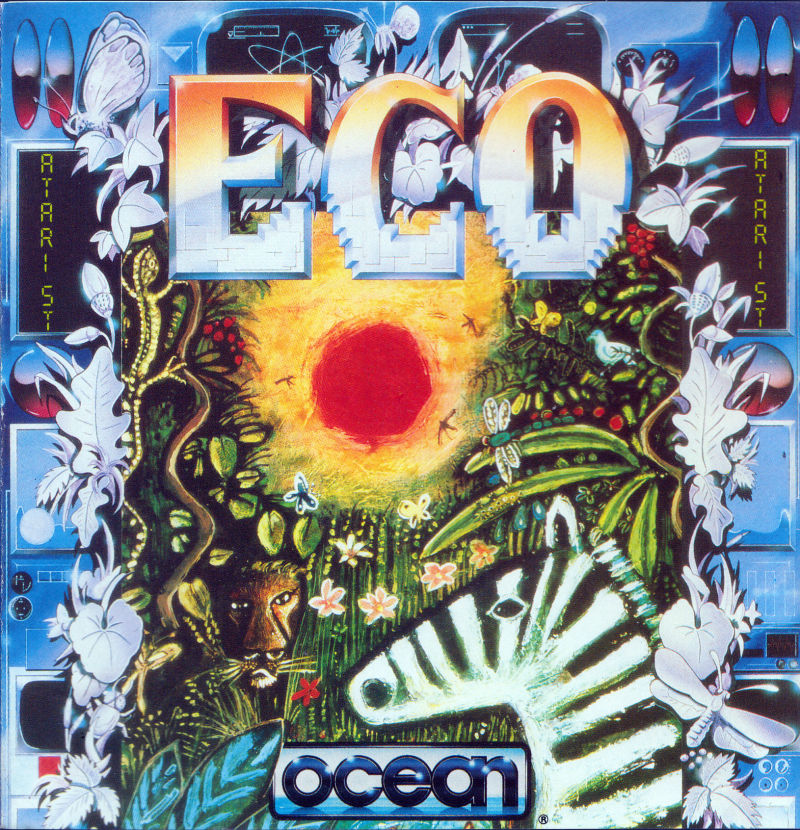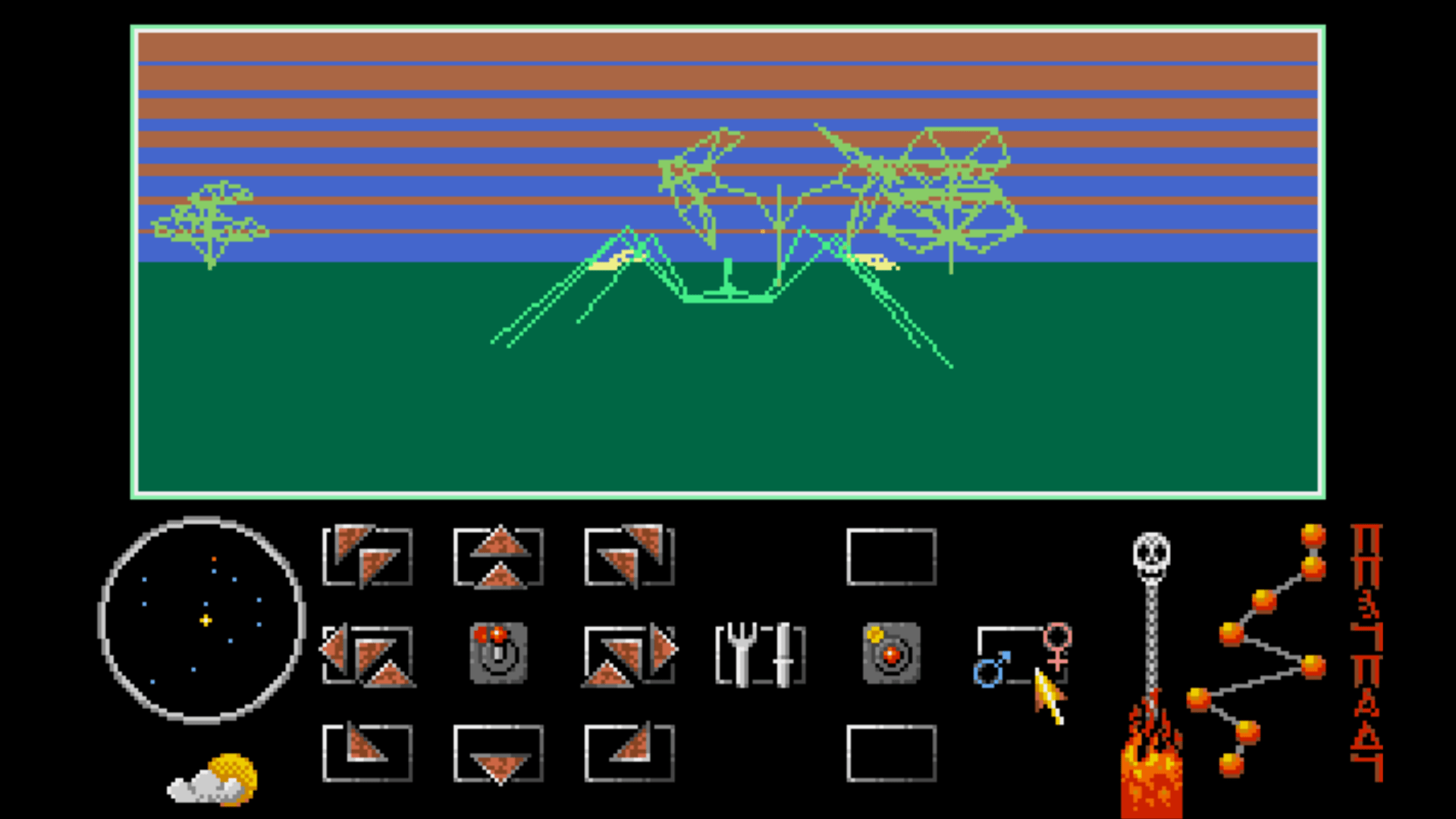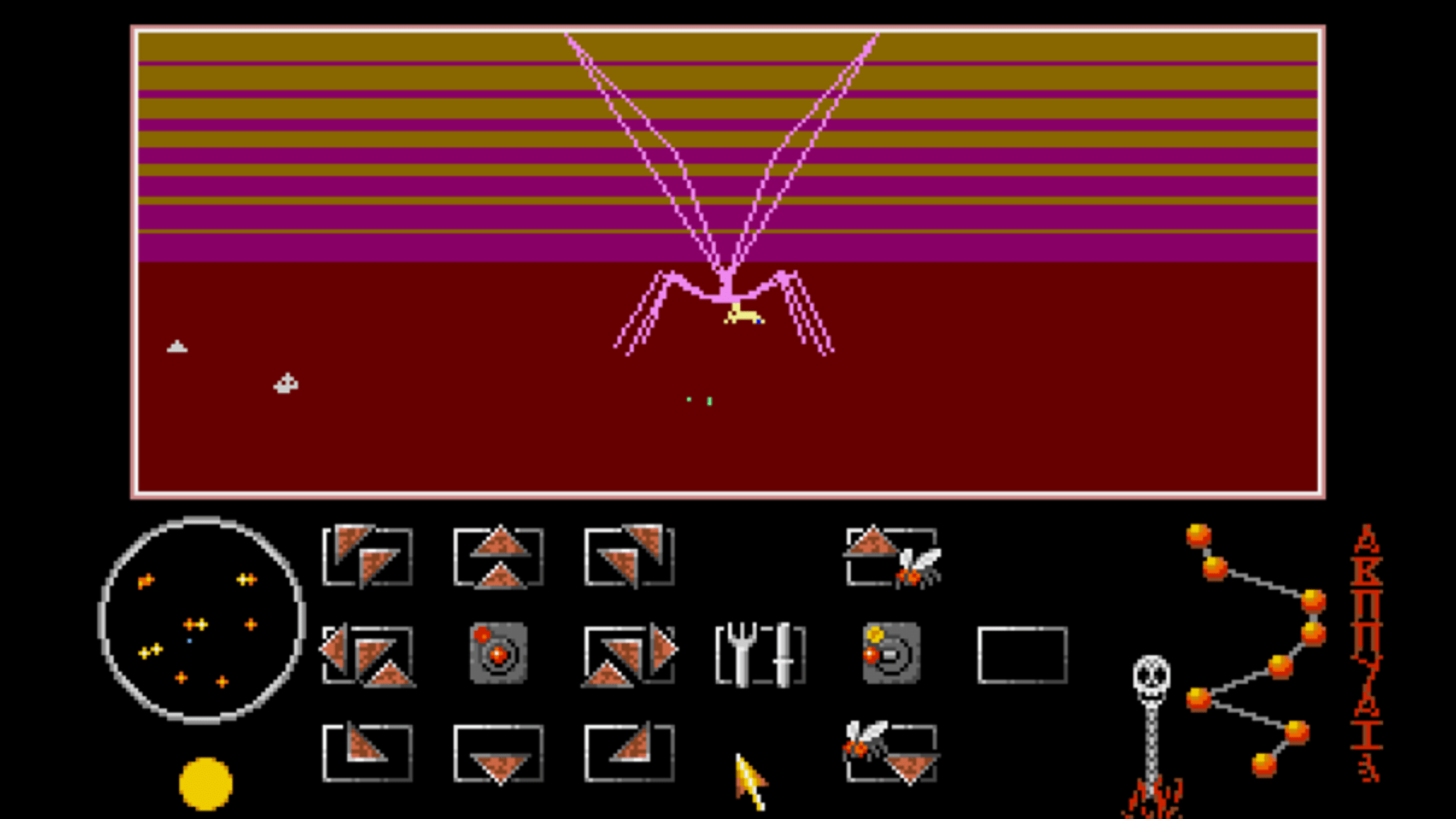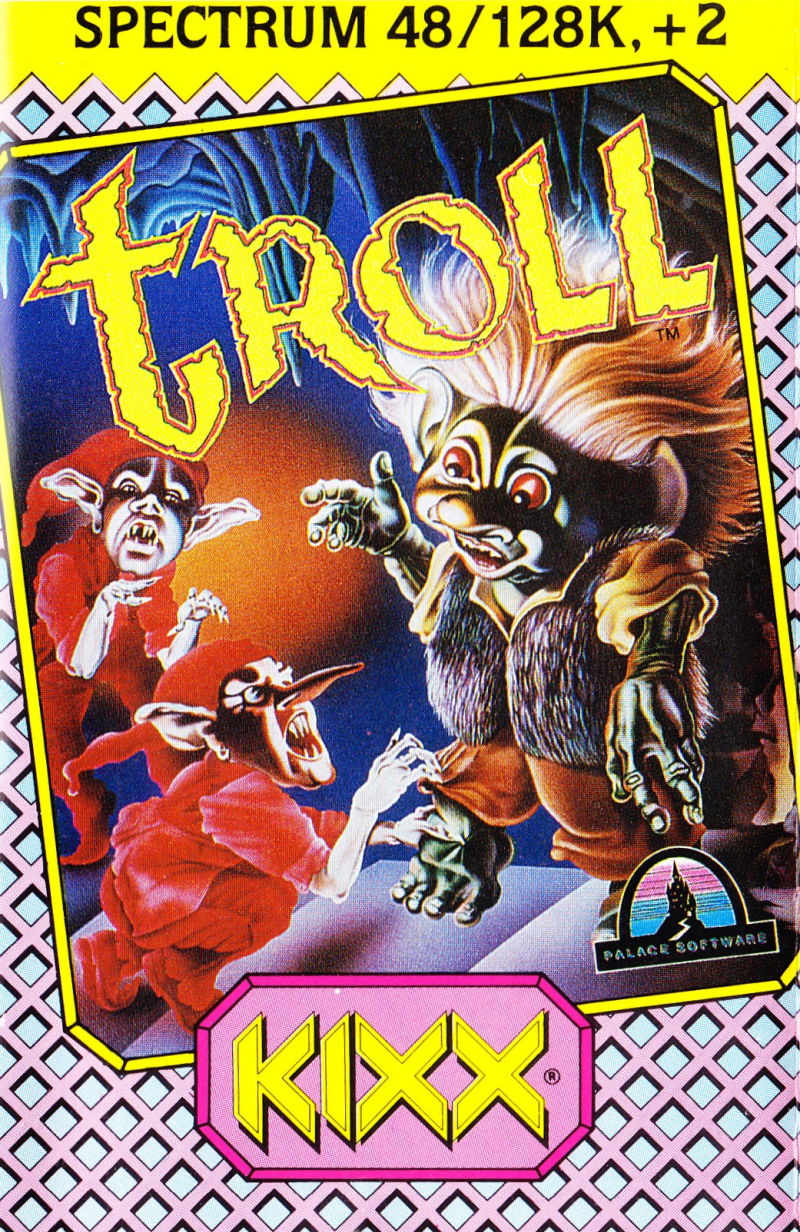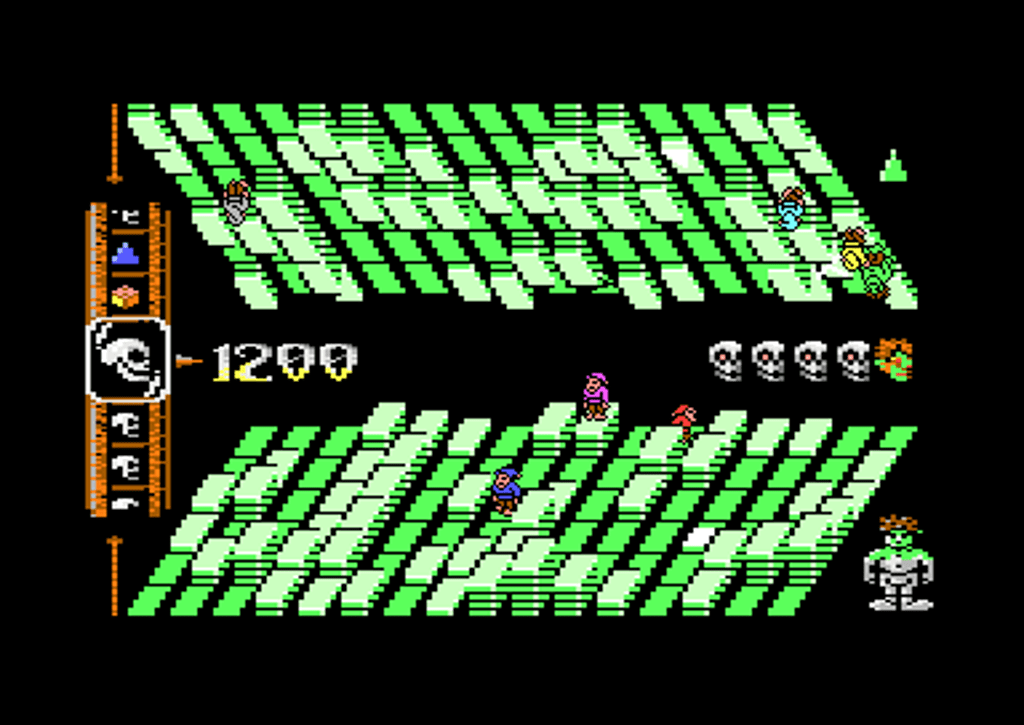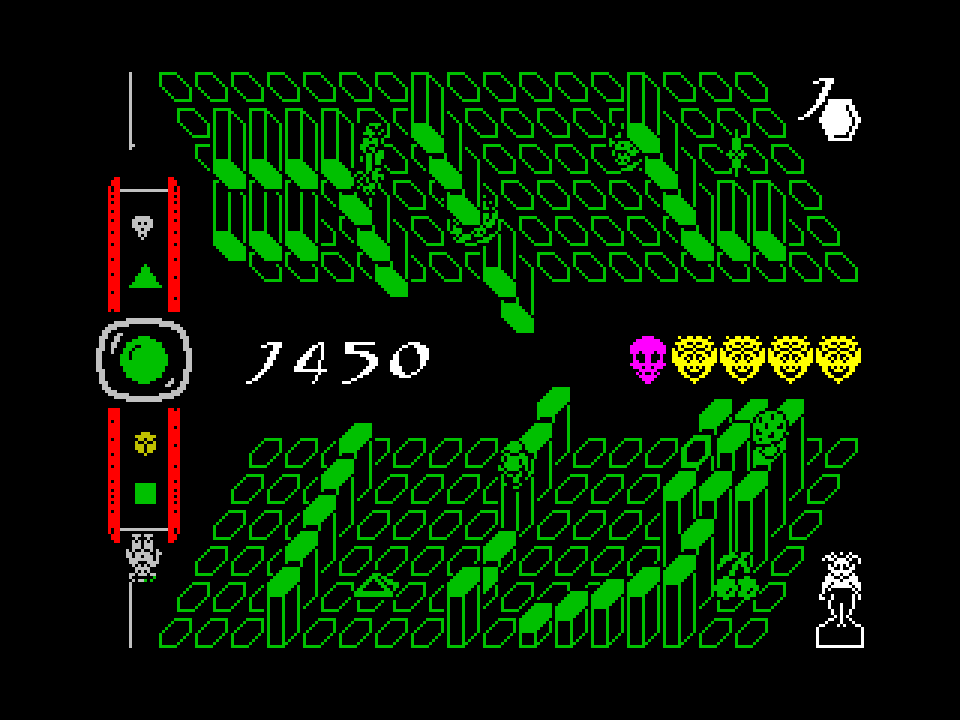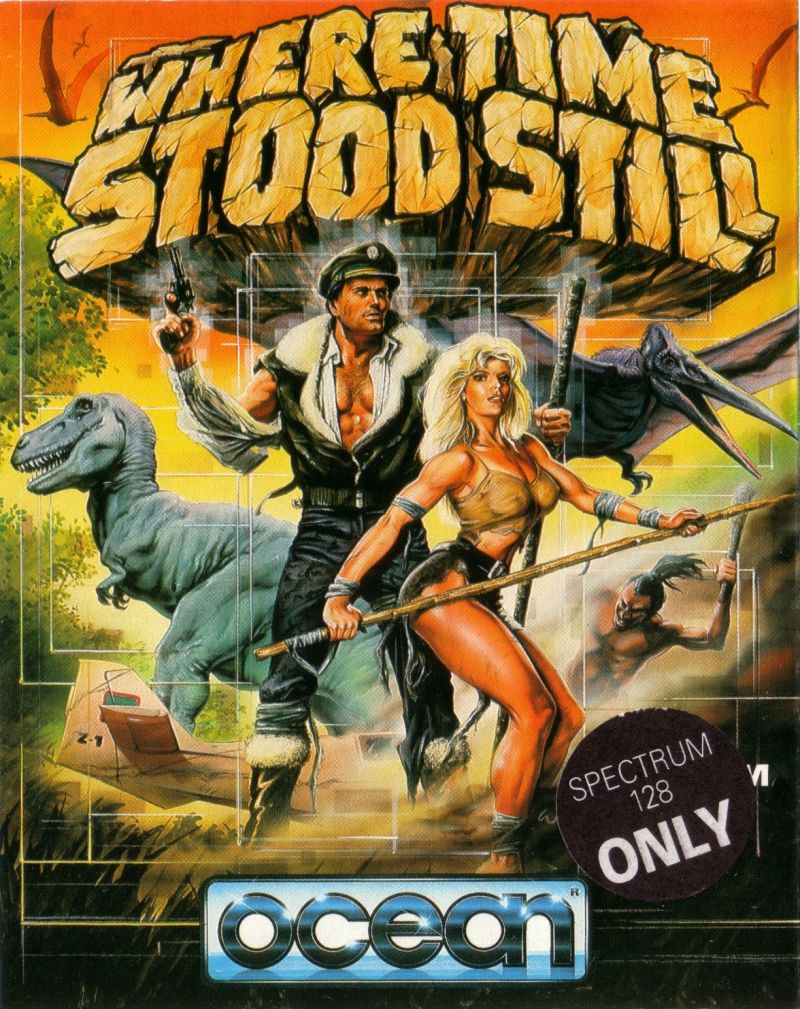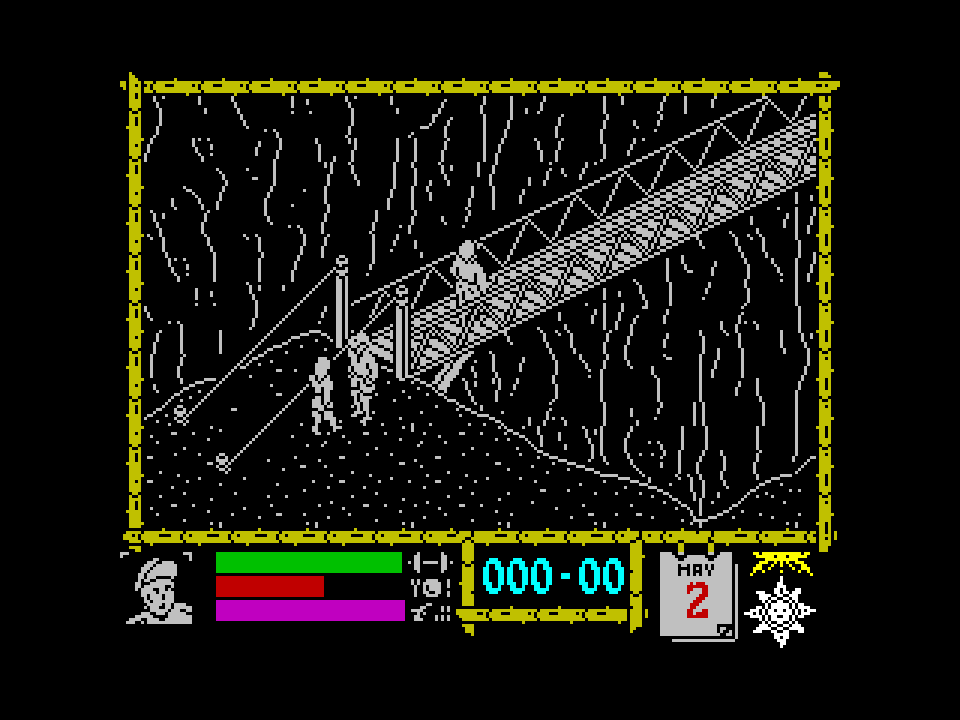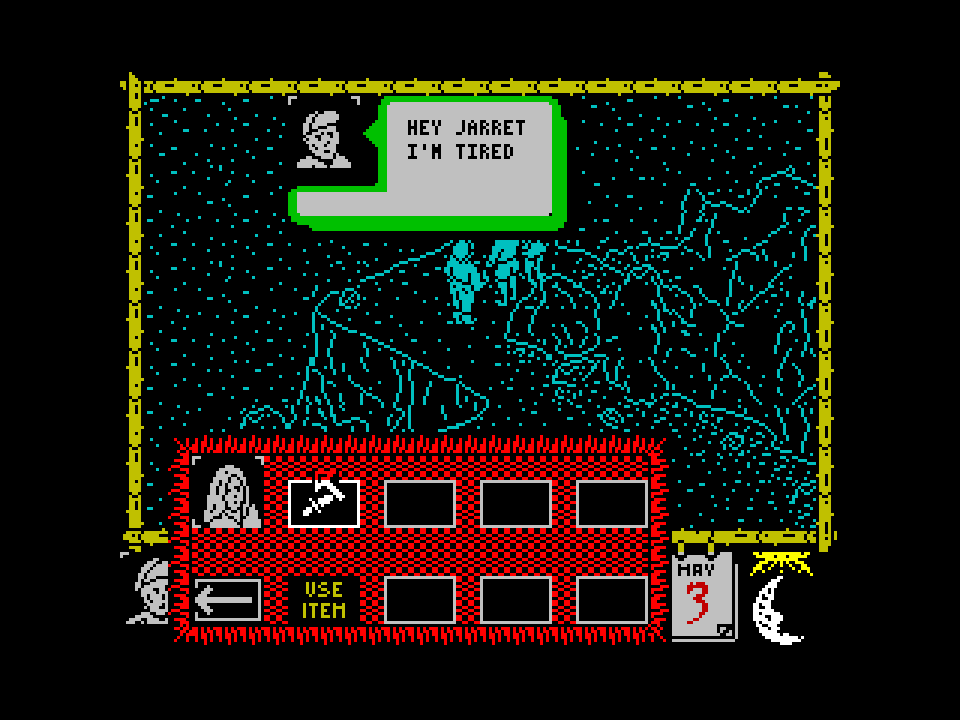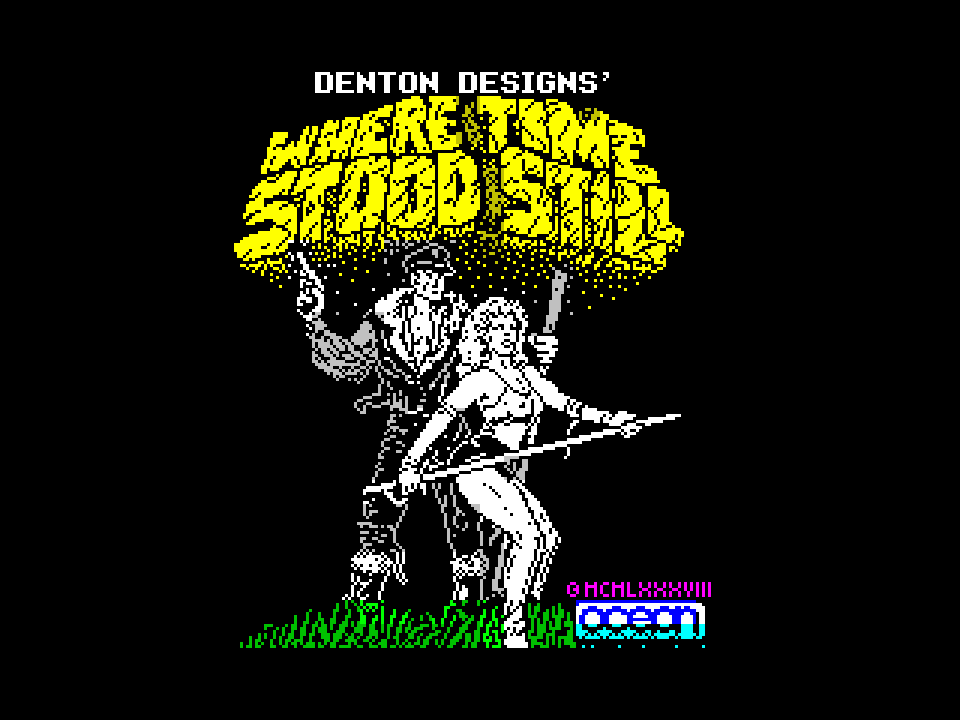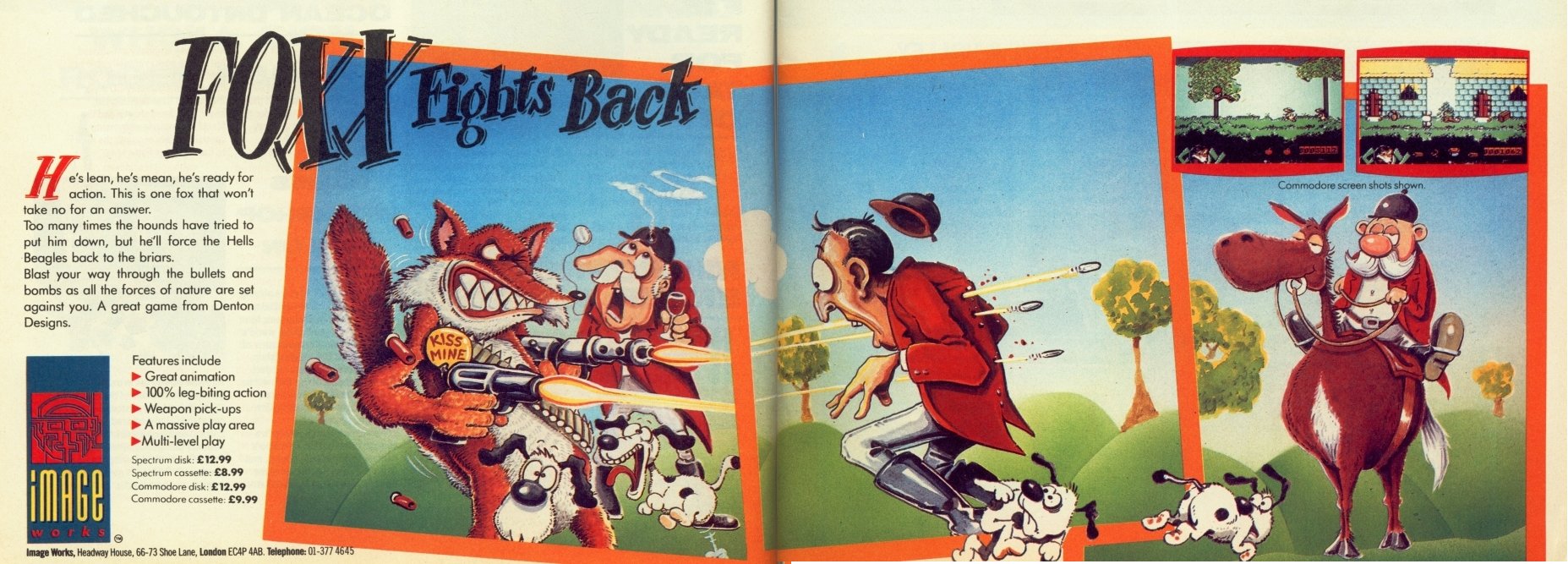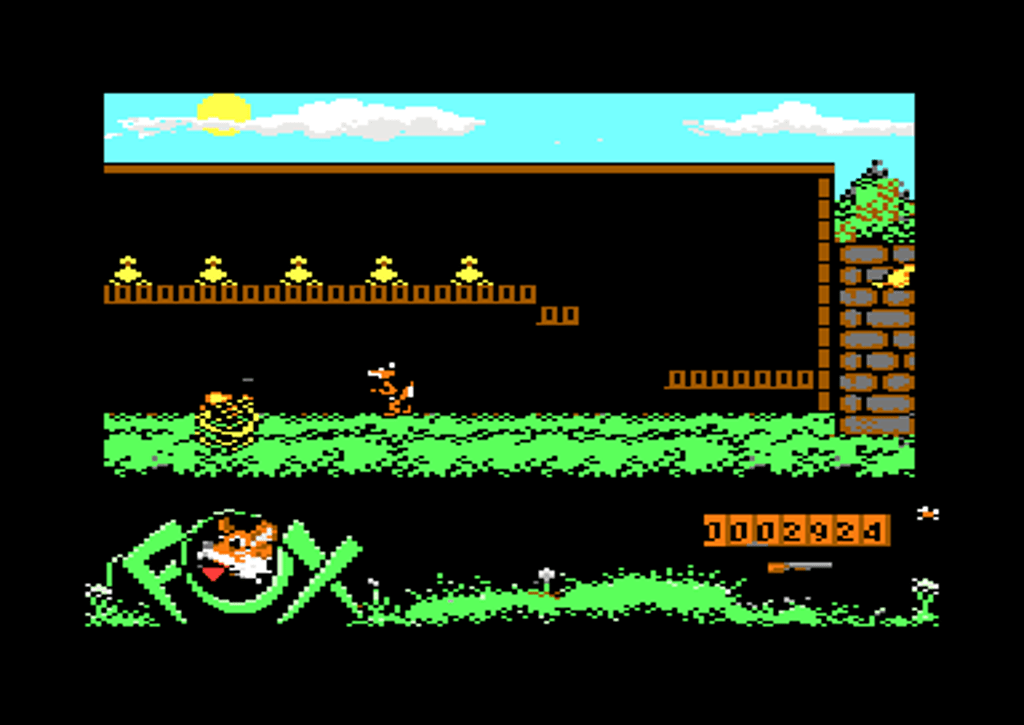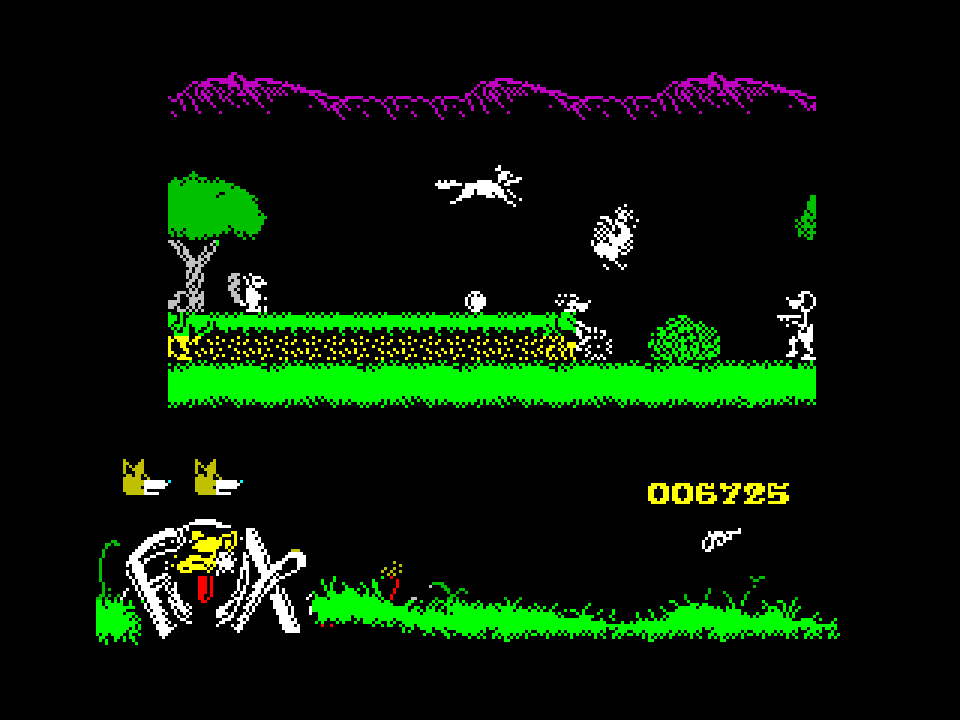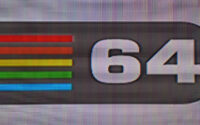Art For The Machines: Part V – Gifts For The Bits
1988-
ECO (Ocean) – Another shift in the ongoing and never-ending evolution of video games as Denton Designs takes the first leap to the next computer generation with “A Game Of Survival”… Rather fitting, eh?
And trust the Dentons to enter a new platform with a bang. Nobody probably expected Shadowfire 3, Frankie 2, or something “similar”, but what everybody got was another hyper-original game that nobody had ever seen before. (So that’s very “Denton”, already!) The game is ECO. And the theme in ECO is… Evolution. Life itself. So when people have marveled over games like SimLife, the Creatures-games (The 90s / 2000s ones.), and Spore, ECO did it first and in a new forms several years earlier.
And such a game starts suitably enough with a quote from Charles Darwin’s The Origin Of Species. (That famous bit with: “Probably all the organic beings which have ever lived on this Earth have descended from some one primordial form, into which life was first breathed.”) And so begins the cycle – With the generation of life and the conditions where life can exist. The game places you in one of these five randomly generated environments, ranging from “frozen” to “desert” with various species in an eco-sphere. (Arid, temperate, and tropical are the three other climates.) And once your place in the universe has been defined, you find yourself in a vector graphics-based three dimensional world.
Life in its most basic form is about eating and adapting to the environment in order to stay alive. And that’s where the evolutionary journey starts – In this case as an insect or a fly. The insect has six legs, but it does look very much like an arachnid. And as a six-leg, you’re attractive and no doubt tasty, high protein food for the birds. Which brings another basic instinct to existence – The fight-or-flight response. Flight is the most realistic choice at the beginning. Because when you are not munching on stuff that keeps you alive, you are avoiding getting eaten or killed by larger beings. Moving up and down on the food chain is a constant struggle. And when you eat, you grow stronger. But the odds are stacking against you for sure – If you are unable to find food, you’ll starve and die soon enough. The same if you don’t adapt to the current climate. And if you don’t find a mate and spawn stronger versions of yourself, you are the last one out – Even if you make it beyond your expected lifespan.
The moment you start hiding, crawling, or running for your life while looking for food, you’re presented with two windows – The (upper) gameplay window, and the (lower) icon-based controls- / status window. The graphics consist of (well) animated “stick figures” in a landscape with “stick plants / trees” and “stick rocks”. A sun rises and sets in the background, and the color scheme of the landscape changes depending on the climate, weather, and hour of the day.
The controls- / status window has a set of icons, a radar (Without this, the game would be pretty much broken.), a weather indicator, a lifespan / age meter, and your species’ genetic code. (This code is based on the Greek alphabet.) Each of the eight genes is placed on a horizontal point and then linked together vertically via strands from gene to gene. Each gene can furthermore have eight “values”. A gene becomes “available” for modification every time you manage to create a new generation. These determine your appearance as well as characteristics like speed, endurance, etc. For example, changing one specific gene alters the length of a fly’s legs while it changes the length of the body if you are another type of insect. (Alternately, it modifies the shape of the leaves if you have “devolved” to a plant.)
The radar points out everything of interest, e.g., other beings. (Potential food and even more potential dangers.) The lifespan is illustrated as a skull attached to a rod / pillar. (?) The higher up the skull is in the status window, the longer you are expected to live. The flame that also appears from below on the pillar symbolizes the amount of lifespan that has been used up. The blaze mercilessly creeps closer to the skull during a lifetime, and when the skull is incinerated, your being dies… And just like life itself, it’s fragile as hell. A game can be over in ten seconds or in any moment when you get stepped on by something that’s much bigger, heavier, and stronger than you.
The food chain is made up of seven links – Plants, worms, insects, birds, quadrupedals, bipedals, and scorpions. Each one naturally have different characteristics – Just like in the natural nature. Scorpions can only be eaten by birds. Plants survive due to the process of photosynthesis. Bipedals don’t eat worms. And last, but not least: A snake could at worst evolve to a local politician that I would have named Christer. (But the game doesn’t include mechanics for defecating from the mouth or molestation, so he can’t really do what he’s best at.)
Anyway. ECO can be controlled with a mouse or a Joystick. Mouse controls are the most convenient ones when you click on icons and often have to move quickly between them. The Joystick is best suited for the movement in eight possible directions around the landscapes. (Birds and flies have additional icons for taking off and landing.) The only keys on the keyboard that are the arrow-keys and two Function ones. The arrows are used to change the camera’s view point in the gameplay window. The up- and down arrow keys moves you towards and away from your being, while the left- and right arrow keys spins the view counterclockwise and clockwise. Additionally, the F1- and F2-keys move the view point up and down respectively. (The DEL-key places the camera directly behind the being, which saves you from trying to do it manually when you most likely have more pressing business to tend to.)
The fact that you can view your sole survivor from hundreds of angles may not be unique in any way, but it was a very original feature in 1988. (This was previously mostly known from flight simulators and such.) And in a game like ECO, it can be very useful to see what’s around you – All the time. The stylishly minimalistic graphics are pretty much one of a kind too. The frame-rate is not optimal for these types of visuals, but they get the job done.
The other two icons are the most important ones: Food and Reproduction. (The Food-icon looks like a knife and a fork, and the reproduction one has the astrological symbols for Venus and Mars.) Click on them to go hunting for grub or someone to grind genitals with. (The latter when you are old enough, god damn it.) When you have found a compatible partner (Within your own species, god damn it again.) and successfully conducted the business of reproduction, you may enter the “Gene Design Screen”. This is where you play the Omnipresent Creator and are able to alter the DNA-parameters. The genetic code can be changed manually on this screen by moving the genes on an axis. (All eight if you have evolved far enough. The ones that you can change are marked with a key.) Your creature appears in three smaller separate windows called: Front View, Side View, and Plan View. Clicking on the on-screen die randomizes the value of the gene. The being changes appearance dynamically in the three windows every time you meddle with its genetic code. Will your create a weakling, the rectal-born son of Christer, or a true survivor? – Only ECO has the answer! Get on, and roll the genetic die. (Or roll in the dust and die, more like.)
And when you have become extinct (Nothing lasts forever.), you have no other option but to click on one of the Skull-icons to enter the Post Mortem-screen. This screen displays your Genetic Code (If you want to re-create the being in a subsequent game or strive for becoming like that creature’s ancestor.), cause of death (Usually starvation or getting killed.), how many generations your kind survived, the amount of food eaten, and survival time.
ECO really has a good and original atmosphere, powered by Fred Gray’s amazing and excellent soundtrack. (Don’t worry – He wasn’t one of the (too) many musicians who used Soundtracker and the ST-01 disk for the instruments. Which always was a big risk in the late 80s.) The game has two tunes that are like The Best Of Gray. The music can be switched for sound effects. (And you can’t have both, unfortunately.) ECO is also available for the Atari ST, and this version is reportedly one of the few games that utilizes an optional MIDI-powered soundtrack. (For those who have a keyboard connected to the computer, obviously.) But the in-game music sounds a ton better on the Amiga.
After playing ECO for a good while and getting into it properly, it’s not impossible that the glimpse of hope turns into a blazing fire – Just like when the last example of a dying species finds a way to reproduce and continue the cycle of life. It did mirror something outside this masterpiece of a game. Sure, it all looked a little different, but there was new hope that future Denton-games published by Ocean would turn out to be even more sophisticated and ground-breaking… Unique software for the new generation… Well, what can one say except: How utterly deceitful and frail hope can be sometimes… — Release: Winter / Early (February) 1988 · Credits: Stoo Cambridge, Fred Gray, Colin Parrott · Commodore Amiga (Disk)
Troll (Palace Software / Outlaw Productions / Kixx) – At this point, there was a notable shift in the quality regarding the games that Ocean decided to publish. (Special FX’s G.U.T.Z. was good, though. And Firefly was bloody excellent. With music by Fred Gray and graphics by Karen Davies – How could it not have been?)
Gary Bracey at Ocean said in From Bedrooms To Billions (2014): “From a business perspective, licensing meant marketing. And basically what we were buying were brands. We were buying awareness. Because, of course, you can spend tens of thousands or hundreds of thousands, and in these days millions, on marketing and promoting an unknown product, but when you take something like RoboCop or a Coin-Op, you have a ready made brand and an awareness, an established awareness, of a title that saves you a lot money on the back end.”
Can we ever be sure that this is as good as it sounds? Like a way forward when your games just don’t stand out among the rest? But Ocean had already released so many high quality games for years. And isn’t this focus on brands a sneaky incentive to perhaps not always give a 100% when developing the games themselves? Even if there is a subjective point of view, there is also the history with two sides of one coin. But it’s no small wonder that things change after each bitter divorce… There was still one more Denton Designs game coming out in 1988 from Ocean, but to the outside, the real sign of trouble brewing was that other advertised game called Flashpoint that “never” got released… (More about that later.)
Anyway. We are not there quite yet, and this licensing business wasn’t all about digging deeper and deeper holes for oneself. Digging holes is partially Humgruffin’s problem in this game called Troll. Humgruffin is also a Troll, and Troll the game was semi-oddly enough published by Palace Software instead of Ocean. (Did Ocean somewhere along the way convince themselves that they didn’t need to release the type of original games that helped bringing them to where they were towards the end of the 80s?)
Another Denton Designs game of course meant that it was going to be something new and / or fresh. Paul Boughton, who reviewed Troll for Computer + Video Games in issue #78, said it best: “There are very few times when you come across a game which fails to fit at least partially into well-established categories of computer games.” Because Troll doesn’t look like any other action platformer. (And no one could “borrow” the idea without everybody noticing.) Its unique perspective with two levels simultaneously on screen, tilted inwards, brings an extra dimension to the whole genre. But this wasn’t the first time graphics artist Stuart Fotheringham visualized new points of view and “mirrored” split screens on the same screen. (Meaning that there is a direct connection between the two.) Remember this when we return to the aforementioned Flashpoint in the next part…
Humgruffin has ended up in the peculiar realms of Narc where there is a second ground upside down right above the regular one. The two symmetrical ground levels are constructed from tiles in various shapes, placed in two separate 16×6 grids. (17×6 tiles in the Spectrum-version.) The shapes are either circles, triangles, quadrangles, pentagons, or hexagons. But there are also tiles stacked on top of each other, which creates the differences in height on each level. This also directly results in there being pathways and steps randomly formed around the grids. Humgruffin can only leap from tile to tile as long as it’s at the same height as the one he is standing on, or, if his destination tile is one step (tile height) above or beneath him. If he does a running leap, he can take two steps (Vertically, that is.) in one go. Humgruffin isn’t much of a climber otherwise, and dropping down from a stack of five tiles just isn’t his thing.
Humgruffin’s prime mission is to get the hell out of Narc. To accomplish this, he has to find six crystal gems for a wedged amulet looking like a “Trivial Pursuit”-piece. This amulet has some serious powers. (In the Spectrum-version, the amulet is shown as the representing shape with a number.) There are five different types of levels, and to complete the amulet, Humgruffin has to find all the crystals in one level. However, Troll does have some game breaking bugs if you are haunted by the video game Gods of misfortune. A crystal can very likely appear on a tile that you can’t reach for the height- and jump-related reasons mentioned earlier. (It’s a fair guess that there wasn’t enough time to playtest the game properly.)
Narc is populated by various goblins that are kind of dicks. They have a habit of conjuring tiles and carelessly placing these around the grid. (Regardless of the crystals’ positions.) Either the goblins build the existing stacks of tiles higher, or they cause your indirect demise by trapping you. (Or making you fall into a hole.) For example, when you have stacks that are two or three tiles high on the adjacent tiles in all four directions, you simply can’t move anymore. Goblin pricks. But as Humgruffin leaps and shuffles around, he can give them goblins some of their own medicine. Because he too is able to throw literal cracks at the tile adjacent to the one that he’s facing. What happens when Humgruffin steps on a cracked tile depends on what the goblin-powered Wheel Of (Mis)Fortune on the left side of the screen shows. If it displays a skull in the middle, Humgruffin sinks into the ground, dies, and loses one life. Any of the five different shapes sends you to the corresponding world if you chuck the tile on the floor and walk onto it. The die conjures a random tile.
Items appear on the ground as well. Various fruit (Bananas, cherries, lemons, apples, etc.) grant extra points. The appearing and disappearing Mushrooms can be jumped on in order to spin the Wheel Of Fortune one step per jump. Hearts equal extra lives. The pyramid-shaped tiles send you to the opposite side of the level. There is also a light moving around the level that also steals one life. The goblins can be put out of commission for a while using the cracks or throwing various items at them. Rubbing against the foul goblins is another bad idea. You don’t die immediately, but you get gradually calcified from the toes up. (The goblins so happen to want a statue of Humgruffin.) This is shown on the troll in the lower right corner of the screen. (On the C64, the troll is green and turns gray. On the Speccy, it’s black and white and turns into an outline.) In the middle of the screen is your score counter and your lives symbolized as five Humgruffin heads. Lose a life, and one of them turns into a skull.
Fred Gray’s C64 soundtrack is, like in many other games that he has made music for, catchy – It’s for a lack of a better word as it’s a bit like Casino-music in Troll. (I don’t think it’s one of his best tunes either.) And if you get tired of it, there are sound effects that you can switch to.
While Troll was a good attempt at creating something new from old ideas, it didn’t work perfectly. It worked well, though. And with some playtesting and after ironing out some of the bugs, I’m sure it could have reached that 100% functionality instead of 85% like it ended up with. — Release: Spring (April) 1988 · Credits: (C64) Stuart James Fotheringham, Fred Gray, Andy Heap, Ally Noble (Terry Sanders is also mentioned in the Hi-score table.) / (ZX) “Denton Designs”, Stuart James Fotheringham · Commodore 64 (Cassette / Disk) / ZX Spectrum 48K (Cassette / Disk)
Note: Also released for the Amstrad CPC.
Where Time Stood Still (Ocean) – So………… This is it, then… The end of the road in clear view not even at the horizon. The last of the real ground-breaking (And nearly platform-breaking!) original games from the Dentons. Where Time Stood Still with the working title “Tibet” was produced as a spiritual sequel to The Great Escape, and while this magnum opus plays in an entirely different time and setting, it does depict another type of escape. A truly grand one. And this is the team behind The Great Escape going all in. With extraordinary results. And they made sure that the Spectrum-owners hadn’t waited in vain for one more brand new Denton-classic…
But to even load up this ambitious and show-stopping epic, you needed a Spectrum 128K – At least. The cassette-version loads for a good while as the expectations and excitement grows. (This must be where the stories about games that “load for twenty minutes” comes from. An ordinary 48K takes about four-five minutes to load, and this one is three times bigger.) But the game is available on disk too. So 48K Speccy-owners had to upgrade their machines or simply forget about the game altogether… And a potential C64-version… I don’t think anyone who could have done it was even remotely interested. It’s basically impossible to see how the memory limitations could have been circumvented or how many dirty coding tricks they’d had to resort to to cram the game into a single C64-program. So in the end, it would have had to become a multi-load deal. And an open world game in multi-load… Well… It’s one doomed, gameplay flow-terminating deal.
But not as doomed as the scenario that the protagonist and deuteragonists (And maybe even a tritagonist for good measure.) of Where Time Stood Still end up in. A flight over the greater Himalaya is followed by a plane crash. Jarret (The pilot and 24/7 adventurer guy.), Clive (Lard ass rolling in the green from success / luck in the industrial business.), Gloria (Clive’s daughter who isn’t the diva or bimbo that we might think at first.), and Dirk (Gloria’s pretty much useless fiancé.) all survive, but the plane is now in “summer party condition”. (Split in three parts and extra air-conditioned, but you could still potentially have some fun in it.) Some equipment made it to the ground in one piece (Each.), but it’s spread out around the wreckage. There isn’t much to salvage, but Jarret can scrape together some supplies, a first aid kit, a bottle, and a rope. There is also an empty bag that has room for four items. (It’s like an extra inventory as each character can carry four items.)
The quartet soon finds out that they are in a place where no “civilized” person has ever been, and that time really has quite literally stood still here for quite a while. The first giveaway is the Tyrannosaurus Rex and the Pteranodon who appear pretty early on to greet the team welcome in their own way… And the prehistoric animals won’t be the only interesting beings that Jarret and company will encounter. There are some pretty wild animals and other surprises that have evolved during this timeless age. (And in quite a different direction than elsewhere in the world.)
The ordeal in Where Time Stood Still begins on May 1st, and the player initially controls Jarret. Between the crash site and the road to GTFO is a pretty damn big isometric four-way scrolling area that consists of labyrinthine rocky roads, swamps, rivers, forests, waterfalls, two villages, and open areas. The sheer size of the map is what’s mostly original about this game. (We are talking somewhere closer to 450 screens in total.) Arcade adventures in the late 80s could be pretty big, but there was quite nothing “every day” like this. (You can’t really count RPGs in this context.)
The game controls are based on ordinary Joystick- or keyboard ones with a nifty window-based menu system. The Space-bar is used to access the two menus, and the Fire-button is used for selecting icons and options, plus the two actions in game. (Running and shooting.) The menus can be moved freely around the screen if they (occasionally) get in the way. Simply hold the Fire-button over an “empty” non-functional part of the window to move it. Once again, Denton Designs shows how it’s done – Without making things more complicated than they need to be.
The cyan-colored window is where you choose between music and sound effects. And you can pause or start a new game. The four icons with character portraits are used to access each character’s inventory. (Which is a red window.) Items carried are shown as well as what objects can be seen close by. The characters can carry four items at once. To pick up a found object, click on it and then click on a free slot in the inventory. (Or the bag. This opens up a separate green window.) The item doesn’t have to be pixel-exactly inside the slot in order to place it, but it mustn’t be too far outside either.
The last icon is the pretty self-explanatory “Use Item”. (You can always guess what it does.) Discarding items are done in the opposite way, by moving an item from the inventory to any of the empty slots beneath it. (This places the item in the “world”, and it can naturally be picked up again.) The “Cancel” button after you have select to use an item is also not very hard to figure out. Just like the left arrow that takes you back to the previous window or back into the game. Ingenious design, once again. The items in the inventory are color-coded as well. Full supplies are like all other items white. The colors then range from green to yellow to red, i.e., a red bottle means that it’s nearly empty.
If or when Jarret dies, you select a new leader from a magenta-colored window similar to the cyan one. Likewise if more characters croak during the adventure. If everybody dies the game doesn’t start over until you select a new game from the menu. A game can naturally (Due to its length.) be saved at any moment. But the main goal is to make sure that everybody survives this 8-bit answer to a bunch of gritty adventure movies all rolled into one. The dangers are many and you won’t see some of the twists coming. And some discoveries, e.g., what you can do in the game, are moments of true awesomeness.
Below the playing area is the status display. It shows the current leading character and three growing and shrinking bars – One green (With a dumbbell next to it.), one red (With a dinner plate, knife, and a fork.), and a magenta one. (With a pistol and some bullets.) These logically represent the character’s strength, hunger, and ammo supply. The game also keeps track of your score, days passed (Illustrated with a calendar.) and whether it’s day or night. (The surroundings turn black and cyan during the night – Instead of black and white. And the status panel either displays a sun or a moon.) The score counter uses an original format and it starts with: “000-00”. The first three digits equal the percentage that measures your success, and how much of the game you have completed. The last two increase when you manage to kill something.
The graphics definitely deserve praise 24/7. Everything looks very stylish and the amount of detail is astonishing. It even puts many 16-bit games to shame. (Not taking the amount of colors into account, obviously.) The visuals alone increase the atmosphere that lies thick over the game from the first moment. You can tell that the team worked very hard on the game and for a very long time. The music was written by Fred Gray. While it’s not his finest minute and a half, it’s a pretty catchy and melodic track with a suitable “dangerous adventure feel”… Yeah. A minute and a half, because the tune is barely 90 seconds long = You might find yourself switching to sound effects after a couple of rounds. However, the effects are good and quite useful as they often reveal what’s close and around you. (Like a certain submerged monster that generates that famous two-note “Jaws”-theme.)
But a big part of the gameplay is how effectively you look after your pals. You are immediately in full survival mode from the very beginning. Gloria, Dirk, and Clive follow their natural leader, but you have to pay attention to what they say. Speech bubbles pop up on screen every now and then with messages like: “I’m thirsty.”, “I’m hunrgy.”, “I’m tired.”, etc. (And of course the internationally well known: “Help.”) You have to get to “know” the characters so that you can figure out who’s the incurable whiner of the bunch and who really only complains when it’s justified. And that’s when you should pay attention. The team can also split up and go separate ways, and when you select a character, the viewpoint simply jump-cuts to that character.
Where Time Stood Still is a game that invites the player to explore and experiment with its surroundings. It has the exact right balance between everything that makes a video game click. Combine this with a unique art-style, a classic video game soul, and an excellent interface (That must have inspired countless games.), and you have the finest piece of software to ride into the sunset with. Because after this top game, there was only one way to go. And without Ocean who completely was losing touch with their own roots at this point. This essentially meant that we would never see the classic Denton-games again. And if that isn’t one of the saddest moments of realization in the history of the 8-bit computers, I don’t know what the hell is… Things would never be the same going forward, and it’s usually better to burn out than fade away…
But there were still a couple of unpublished (yet finished) Denton-gems brewing. (In entirely different categories.) And another change towards the worse – So bad in fact that we might have never even seen a couple of real gems. — Release: Summer (July) 1988 · Credits: Fred Gray, John Heap, Ally Noble · ZX Spectrum 128K (Cassette / Disk)
Foxx Fights Back! (ImageWorks, 1988) – However, there was one more Denton-original ready for 1988…! Although it was oddly enough coming out via Mirrorsoft’s label ImageWorks. Foxx Fights Back! was the label’s first published game along with Antony Crowther’s Fernandez Must Die. Even if ImageWorks was focused on the Amiga and the Atari ST, they still released the occasional game for the C64 and Spectrum up until their demise in the early 90s. (Slightly paradoxically, Foxx Fights Back! was ImageWorks’ only game that didn’t come out for neither the Amiga nor the Atari ST.)
But what could we all expect after a game like Where Time Stood Still? Maybe an announcement or a teaser for the next epic (Which always seemed to appear after a couple of more “familiar” games.) while another long development- and production cycle was taking place…? Unfortunately, it all proved to be quite the opposite and that changes were on their way. No epics. And no original, jaw-dropping and eye-opening software for the old machines in sight. Well, unless you count this charming slice of simple fun…!
The full ad for Foxx Fights Back! didn’t make it to the box art for the cassettes and discs (Due to the dimensional limitations of those.), but the two-page spread advert in the magazines is absolutely fuckin’ hilarious – An enraged fox dressed in nothing else but a bullet belt and a “KISS MINE”-badge. And he is armed with two powerful firearms. Foxx the fox has just put three bullets of hot lead through an agonized fox hunter. Another one, paralyzed with fear, has almost got his brains blown out as a bullet has went through his hunting cap. And around them are four running dogs that are scared shitless.
But what was it that lead to this situation where the tables finally turned? Well, the foxhounds have made several attempts to end his life earlier. And now, when even the Snoopy-looking Beagles are packing heat in the wild, enough is enough – Time to make a final stand and show that this fox is the wrong one to be fucked with. And beyond that, Foxx needs to gather food for the upcoming winter. Mrs. Foxx sends him out on this particular mission, so he’d better bring the gun just in case, and get to it. Meanwhile, Mrs. is waiting at home, always ready to start swinging the rolling pin if Mr. returns empty handed. It can and must never be too easy. Not even in sideways scrolling mixtures of running, gunning, collecting, and jumping.
Foxx does all this across approximately a fifty screens wide area in his quest for food. He can only carry four food items at the same time, and they have to be delivered to the burrow. (The entrance is a couple of screens from the far left end of the map.) Every time this happens, Mrs. declares him her hero. (But return without a single apple, and the talk isn’t quite that sweet!) And outside is no place for quiet strolls in the countryside – Squirrels throw nuts at you, hens bombard you with eggs, and the trigger happy Beagles even chase you around on motorcycles. (!) Kill ’em all.
To defend yourself, you have a firearm. But you will eventually find heavier weapons out on the fields of green – Or how about a shotgun, a Tommy gun, and a machine gun? (!) That should stop everybody from trying to stop you from “finding” some food. Foxx has three lives from the beginning. And a stamina meter. And what kind of clever stamina meter did the Dentons implement in Foxx Fights Back!? A tongue. Mr. Foxx in the “Fox”-logo in the lower left corner is panting with his tongue hanging out. The more stamina he loses, the longer the tongue gets. Stamina is restored every time you bring some food to the stash or when you manage to devour some fresh chickens or bunnies. The latter can be found in other burrows, and a couple of these provide a subterranean shortcut closer to home. Another way more lethal danger includes water for a fox that can’t swim. Colliding with any type of wall is also an effective way to reduce Foxx’s stamina. Extra lives are provided once per level, according to the instructions. (I just wonder how many “levels” there are in the end, like rounds of New Game+ in modern games.)
Here and there are sections that have double “levels” – The always horizontal ground one and elevated ones, for example stone walls and grassy slopes that Foxx can jump onto. Both versions (The C64 and the Spectrum.) play really well, although they feel quite different when it comes to the controls. For example, it’s slightly easier to make leaps on the Speccy. This is done with the upward diagonal directions of the Joystick and without the Fire-button pressed. On the C64, you have to hold Fire in order to jump. But Fire is also for firing the weapon when Foxx isn’t running, so you might notice that you sometimes stop dead in your tracks and shoot instead of jump.
Visually, both versions sport excellent Sprite-animations and backgrounds. Then again, this is what we always could expect from this developer – Attention to detail and visuals that differentiate their games from the rest. All the more or less adorable characters (Hedgehogs, squirrels, etc.) in the Spectrum-version present extra details in their, as usual, monochromatic glory. However, on the Speccy, you get a black background – Like the game was mostly taking place in the dead of night. So the C64-version appears like it plays in “daylight” if you will. Fred Gray’s lively soundtrack sounds its best through the SID-chip – Also as usual. The in-game tune (Which is the title-screen tune on the Spectrum.) is a medley of various famous and classic tunes. The 48K- and 128K Spectrum-versions differ slightly on the sound front. The 128K one has better sound effects and the music that’s a couple of steps closer to being SID-great. But there are no in-game tunes or jingles, like there are the C=.
Yeah. Foxx Fights Back! is a fun game that has some serious entertainment value… But once the game was released, there was an alarmingly long period where it was way, way too quiet on the Denton front… And a period where various magazines didn’t mention any upcoming games… So was this it? — Release: Fall (November) 1988 · Credits: (C64) Dave Colclough, Fred Gray / (ZX) John Heap (Ally, Colin, Dave, Fred, John, Paul, Steve, and Stoo are named in the default Hi-score list.) · Commodore 64 (Cassette / Disk) / ZX Spectrum 48K/128K (Cassette / Disk)
(To be continued…)

